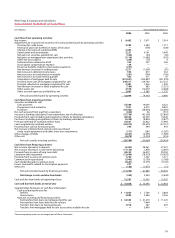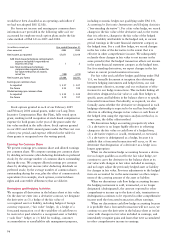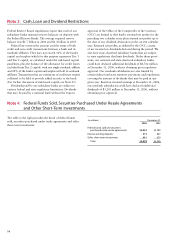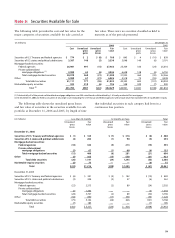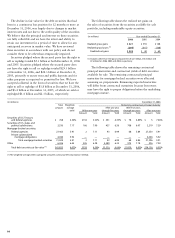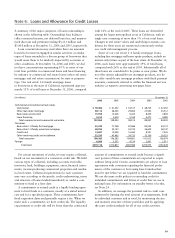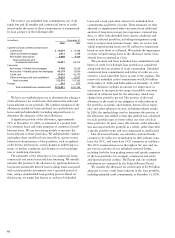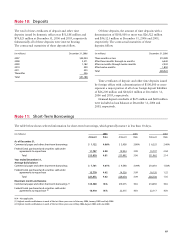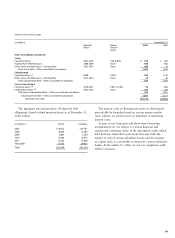Wells Fargo 2006 Annual Report Download - page 83
Download and view the complete annual report
Please find page 83 of the 2006 Wells Fargo annual report below. You can navigate through the pages in the report by either clicking on the pages listed below, or by using the keyword search tool below to find specific information within the annual report.
81
with 14% at the end of 2005. These loans are diversified
among the larger metropolitan areas in California, with no
single area consisting of more than 3% of our total loans.
Changes in real estate values and underlying economic con-
ditions for these areas are monitored continuously within
our credit risk management process.
Some of our real estate 1-4 family mortgage loans,
including first mortgage and home equity products, include an
interest-only feature as part of the loan terms. At December 31,
2006, such loans were approximately 19% of total loans,
compared with 26% at the end of 2005. Substantially all of
these loans are considered to be prime or near prime. We do
not offer option adjustable-rate mortgage products, nor do
we offer variable-rate mortgage products with fixed payment
amounts, commonly referred to within the financial services
industry as negative amortizing mortgage loans.
A summary of the major categories of loans outstanding is
shown in the following table. Outstanding loan balances
reflect unearned income, net deferred loan fees, and unamor-
tized discount and premium totaling $3,113 million and
$3,918 million at December 31, 2006 and 2005, respectively.
Loan concentrations may exist when there are amounts
loaned to borrowers engaged in similar activities or similar
types of loans extended to a diverse group of borrowers that
would cause them to be similarly impacted by economic or
other conditions. At December 31, 2006 and 2005, we did
not have concentrations representing 10% or more of our
total loan portfolio in commercial loans and lease financing
by industry or commercial real estate loans (other real estate
mortgage and real estate construction) by state or property
type. Our real estate 1-4 family mortgage loans
to borrowers in the state of California represented approxi-
mately 11% of total loans at December 31, 2006, compared
Note 6: Loans and Allowance for Credit Losses
(in millions) December 31,
2006 2005 2004 2003 2002
Commercial and commercial real estate:
Commercial $ 70,404 $ 61,552 $ 54,517 $ 48,729 $ 47,292
Other real estate mortgage 30,112 28,545 29,804 27,592 25,312
Real estate construction 15,935 13,406 9,025 8,209 7,804
Lease financing 5,614 5,400 5,169 4,477 4,085
Total commercial and commercial real estate 122,065 108,903 98,515 89,007 84,493
Consumer:
Real estate 1-4 family first mortgage 53,228 77,768 87,686 83,535 44,119
Real estate 1-4 family junior lien mortgage 68,926 59,143 52,190 36,629 28,147
Credit card 14,697 12,009 10,260 8,351 7,455
Other revolving credit and installment 53,534 47,462 34,725 33,100 26,353
Total consumer 190,385 196,382 184,861 161,615 106,074
Foreign 6,666 5,552 4,210 2,451 1,911
Total loans $319,116 $310,837 $287,586 $253,073 $192,478
For certain extensions of credit, we may require collateral,
based on our assessment of a customer’s credit risk. We hold
various types of collateral, including accounts receivable,
inventory, land, buildings, equipment, autos, financial instru-
ments, income-producing commercial properties and residen-
tial real estate. Collateral requirements for each customer
may vary according to the specific credit underwriting, terms
and structure of loans funded immediately or under a com-
mitment to fund at a later date.
A commitment to extend credit is a legally binding agree-
ment to lend funds to a customer, usually at a stated interest
rate and for a specified purpose. These commitments have
fixed expiration dates and generally require a fee. When we
make such a commitment, we have credit risk. The liquidity
requirements or credit risk will be lower than the contractual
amount of commitments to extend credit because a signifi-
cant portion of these commitments are expected to expire
without being used. Certain commitments are subject to loan
agreements with covenants regarding the financial perfor-
mance of the customer or borrowing base formulas that
must be met before we are required to fund the commitment.
We use the same credit policies in extending credit for
unfunded commitments and letters of credit that we use in
making loans. For information on standby letters of credit,
see Note 24.
In addition, we manage the potential risk in credit com-
mitments by limiting the total amount of arrangements, both
by individual customer and in total, by monitoring the size
and maturity structure of these portfolios and by applying
the same credit standards for all of our credit activities.


